
* In the 1920s, a young Soviet air enthusiast named Aleksandr Sergeyevich Yakovlev designed and flew a set of experimental aircraft. Having demonstrated his skill, Yakovlev became established as one of USSR's foremost aircraft designers, developing flying machines in many different roles for the Soviet Union. One of the niches his aircraft fulfilled was the light utility role, with the Yak organization churning out a number of such machines for that task through its history. This document provides a history and description of Yak light utility aircraft.
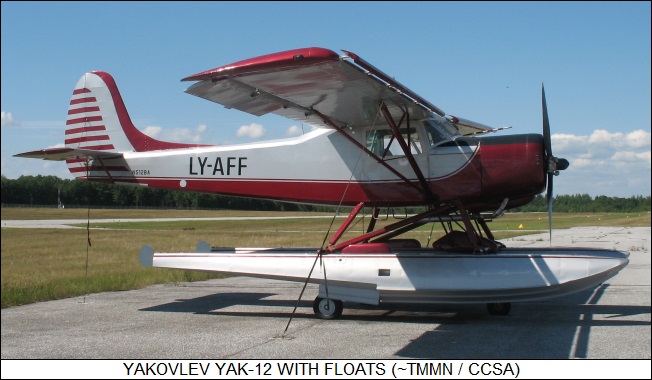
* In 1927, a Russian aircraft mechanic with an interest in aircraft design named Aleksandr Sergeyevich Yakovlev -- born in 1906 and then attending the Red Air Force Academy (VVA) -- decided to build a two-seat light aircraft, intending to enter it into a competition set up by the OSOAVIAKhIM, the Soviet civil aviation society, which promoted aviation among the public and in particular trained youngsters for flying careers, particularly in the military. Yakovlev had built and flown a series of gliders and he quickly got his first true airplane, the "VVA-3", into the air.
It was a straightforward biplane of wooden / cloth construction, with tandem open cockpits, powered by a British-made Airdisco (ADC) four-cylinder vertical inline engine. The authorities were impressed with the machine, which became more formally known as the "AIR-1", "AIR" standing for Alexei Ivanovich Rykov, head of the OSOAVIAKhIM -- Yakovlev always understood the necessity of buttering up officials important to his advancement. The AIR-1 didn't enter production, though decades later a replica was built of this historic aircraft.
However, Yakovlev had got off to a good start, and he quickly followed up the AIR-1 with the "AIR-2" of 1928, which was much the same design but with minor refinements and cleanups. Although the AIR-2 didn't enter production either, several AIR-2s were built, being used to explore various configurations, such as fits of various inline and radial engines; an enclosed cockpit; and floats. As with the AIR-1, a replica was much later put together of the float-equipped AIR-2.
With his next design, the "AIR-3" of 1929, Yakovlev chose to go to a monoplane configuration, resulting in a tidy parasol-winged aircraft powered by a five-cylinder radial Czech-made Walter NZ engine; the AIR-3 had additional fuel tanks for long-range operation. A handful of "AIR-4" machines was built, featuring various improvements such as doors to make it easier for the two crew to get in and out. The AIR-4 had a length of 7.1 meters (23 feet 4 inches), a span of 11 meters (36 feet 1 inch), an empty weight of 395 kilograms (870 pounds), and a top speed of 150 KPH (95 MPH).
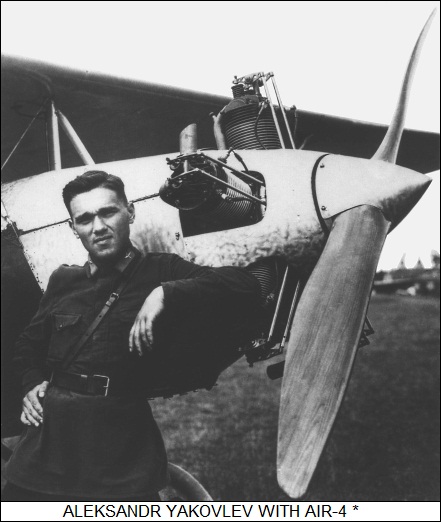
The AIR-4s were used for various tests and trials, including one in which the aircraft was given translucent skinning as something of a "visual stealth" measure. The transparent skin did make the aircraft harder to see, but it was also not durable enough for service use, and that was the end of that idea. Yakovlev also designed a specialized trainer version of the AIR-4, the "AIR-8", very similar to the AIR-4 but with various tweaks, particularly reinforcement of landing gear and the like to tolerate the blunders of trainee pilots. Only one was built, the VVS (Voyenno Vozdushniye Sily / Red Air Force) evaluating it, then forgetting about it.
* With the AIR-4, Yakovlev had finally acquired the maturity to build honestly useful aircraft, coming up with designs for 6-seat and 4-seat machines in 1930. Yakovlev graduated from the VVA in 1931 and was posted to a state factory, where he worked his four-seat concept into a practical flying machine, the "AIR-5". He had the machine flying by late 1931, the aircraft being powered by a US-made Wright J-4 radial engine providing 150 kW (200 HP), a few such powerplants having been purchased by the Soviets for test purposes. The AIR-5 was put through state trials and approved for production, to be powered by the Shvetsov M-48 seven-cylinder air-cooled radial with 165 kW (220 HP).
Unfortunately, the M-48 never reached production, and so the AIR-5 was a nonstarter. However, the substantially less powerful five-cylinder Shvetsov M-11 radial, with 75 kW (100 HP), was available, and so Yakovlev redesigned the AIR-5 to a three-seat configuration, the "AIR-6". After some fits and starts, the AIR-6 entered production in 1934, with about 128 built -- the records aren't entirely solid on the numbers. It was the first true production aircraft designed by Yakovlev, who by that time had acquired his own OKB (experimental design bureau).
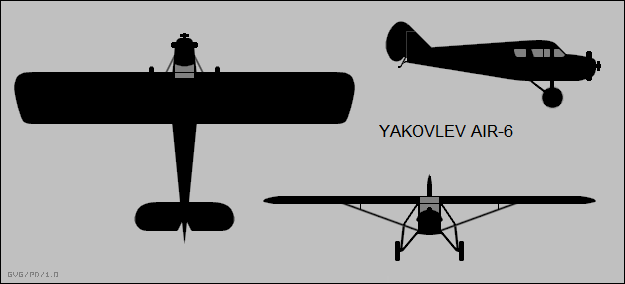
The AIR-6 was a tidy "bushplane" sort of aircraft, with a high strut-braced wing; fixed tailwheel landing gear -- actually a tailskid instead of a tailwheel; an M-11 radial engine, driving a two-blade wooden propeller; and an enclosed cockpit, accessed via side doors, with tandem seating for a pilot and one or two passengers, the aircraft usually being flown as a two-seater. Construction was confusingly mixed, with a steel tube fuselage structure and wooden wings. The AIR-6 looked very much like the AIR-5, except for the five-cylinder engine instead of a seven-cylinder engine; however, the AIR-6 had a slenderer fuselage and an empty weight about 10% less.
___________________________________________________________________
YAKOVLEV AIR-6:
___________________________________________________________________
wingspan:
12.08 meters (39 feet 8 inches)
wing area:
19.8 sq_meters (213 sq_feet)
length:
7.8 meters (25 feet 7 inches)
height:
2.3 meters (8 feet 7 inches)
empty weight:
616 kilograms (1,358 pounds)
MTO weight:
961 kilograms (2,119 pounds)
max speed at altitude:
168 KPH (105 MPH / 91 KT)
service ceiling:
4,600 meters (15,100 feet)
range:
715 kilometers (445 MI / 386 NMI)
___________________________________________________________________
There was an experimental fit of a ring cowling over the engine and spats for the main landing gear; the ring cowling turned out to be so much dead weight, but spats were apparently fitted on some AIR-6 machines in operational service. The AIR-6 could be built with floats or skis, and in fact there was a special "Arctic" version in which all three forms of landing gear could be interchanged in the field. There was also an "air ambulance" version, with a large side door and the ability to carry a stretcher patient, presumably along with a medical attendant.
The service history of the AIR-6 remains obscure, with little information available on how well it was received by pilots, what uses it was put to, and its virtues and vices. Its obscurity suggests it had no great impact and the switch to the low-power M-11 engine, without a comparable reduction in empty weight, hints that it was underpowered. Yakovlev's OKB went on to produce a range of other AIR-series aircraft, leading to development of combat aircraft under the "Yak" designation that would play a major role in the Soviet Union's war with Nazi Germany. The Yak OKB would not return to development of utility aircraft until the end of the conflict.
BACK_TO_TOP* From 1944, Yak OKB engineers worked on two different configurations of four-seat utility aircraft, both powered by five-cylinder radial engines:
The Yak-13 was more modern in appearance and had better performance, but the Yak-10 was judged to have the edge in operational utility, and so was approved for production. Along with the strut-braced high wing, it featured fixed tailwheel landing gear, the main gear featuring spats in the prototype, the spats being deleted in production; a five-cylinder M-11 radial engine driving a two-bladed propeller; and mixed construction, with a metal fuselage, wooden wings, plus fabric skinning.
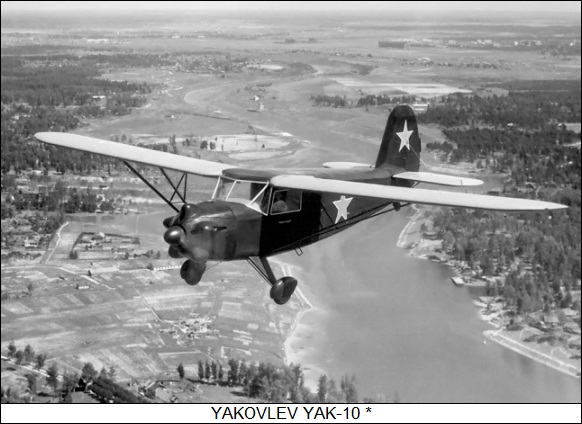
The Yak-10 differed notably from the AIR-6 in having four seats. The Yak-10 prototype was powered by an M-11FM engine with 108 kW (145 HP), but production machines had the M-11FR with 120 kW (160 HP). The distinctive engine cowling featured individual fairings for each of the engine's five cylinders. A total of 40 Yak-10s was built in 1946, including a handful of "Yak-10V" dual-control trainers, plus a few "Yak-10S" air ambulances. The Yak-10S had a long side door for loading one or two stretchers, and seating for a medical attendant. Trials were performed with ski and float landing gear, but those configurations were not accepted for service; it appears that the Yak-10 was simply too underpowered to handle the added drag.
* The small number of Yak-10s built did not reflect any failing of the type; there was simply a perception that it might be improved on, leading to the introduction of the "Yak-12" in 1947. It was assigned the NATO reporting name of "Creek".
At the outset, the Yak-12 was hard to tell from the Yak-10, the main difference being that the fuselage was cut down from the wing to the tail, presumably reducing weight and certainly giving it a lighter appearance. Typically, though not always, there was a triangular cargo hatch on the left side of the fuselage behind the cockpit. The M-11FR engine was retained. This "first series" Yak-12 was built in dual-control trainer and agricultural / crop sprayer variants, being given the designations "Yak-12UT" and "Yak-12SKh" when anyone bothered to make the distinction. Such subvariant designations will not be belabored further here.
___________________________________________________________________
YAKOVLEV YAK-12:
___________________________________________________________________
wingspan:
12.09 meters (39 feet 8 inches)
wing area:
21.6 sq_meters (232.5 sq_feet)
length:
9 meters (29 feet 6 inches)
height:
3.12 meters (10 feet 3 inches)
empty weight:
830 kilograms (1,830 pounds)
MTO weight:
1,185 kilograms (2,610 pounds)
max speed at altitude:
170 KPH (105 MPH / 90 KT)
service ceiling:
3,000 meters (9,850 feet)
range:
810 kilometers (505 MI / 440 NMI)
___________________________________________________________________
Although Yak-12s were flown with ski landing gear, experiments with floats once again demonstrated the aircraft was too underpowered to handle them well -- though it's not that hard to find photos of Yak-12s with floats, suggesting they were flown in some numbers.
The lack of power was a concern, leading to fit of a Yak-12 with a nine-cylinder Ivchenko AI-14 (AKA M-14) radial engine, with 186 kW (250 HP), fitted in a cylindrical cowling. This experiment working out very well, in 1950 production went to the second-series "Yak-12R", with an AI-14R engine providing 194 kW (260 HP). The airframe was also redesigned, featuring more metal construction, plus a modified wing with greater span and a fixed leading-edge "slot" AKA "fixed slat" -- a short-span curved airfoil fitted at the wing leading edge to reduce stall speed, giving the Yak-12R excellent short take-off and landing (STOL) performance. Sources indicate that the Yak-12R also had a blade that could be lowered from the rear fuselage to act as a plow for short landings on grass strips; it is unclear if this item was standard kit.
Along with utility use, some Yak-12R machines were used by Soviet sport aviation groups for parachute jumping and as a sailplane tug. For parachute jumping, an external step was fitted; sailplane tow use involved fitting a tow hook, rearview mirror, and guard wires under the rear fuselage to prevent damage to the tailplane should the sailplane rise above the tow aircraft. The Yak-12R was also built in dual-control trainer and air ambulance variants.
The Yak-12 continuing to be popular, in 1954 the Yak organization introduced a third series, the "Yak-12M", much the same as the Yak-12R, even retaining the AI-14R engine -- but with a redesigned rear fuselage and tailfin with a forward fillet. The Yak-12M was built in dual-control trainer, air ambulance, agricultural, and air club parachutist / sailplane tug configurations.
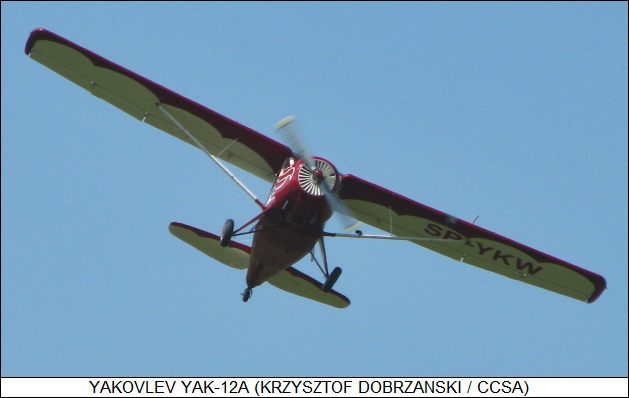
The fourth and final series of the Yak-12, the "Yak-12A", was introduced in 1957. The major change was improved cockpit and passenger accommodations, with features such as yoke instead of stick control, plus better heating and ventilation. Other changes included:
The Yak-12A was built in agricultural and air ambulance versions. One was modified to a biplane configuration, the "Yak-12B", something along the lines of an Antonov "An-2 Lite". Although short-field performance unsurprisingly improved, flight performance unsurprisingly also declined, and so the Yak-12B was not put into production.
___________________________________________________________________
YAKOVLEV YAK-12A:
___________________________________________________________________
wingspan:
12.6 meters (41 feet 4 inches)
wing area:
22.6 sq_meters (244 sq_feet)
length:
9 meters (29 feet 6 inches)
height:
3.12 meters (10 feet 3 inches)
empty weight:
1,060 kilograms (2,340 pounds)
MTO weight:
1,590 kilograms (3,505 pounds)
max speed at altitude:
220 KPH (137 MPH / 119 KT)
service ceiling:
4,000 meters (13,120 feet)
range:
800 kilometers (500 MI / 440 NMI)
___________________________________________________________________
About 3,800 Yak-12s were built to end of production in the USSR. The type was also manufactured elsewhere. The Chinese built a number of first-series / M-11 powered Yak-12s, as well as what appear to have been their own derivatives of the Yak-12, though specifics are unclear. There was also interest in license production in Bulgaria, but that went nowhere. The most substantial license production was by the Polish WSK-4 organization, with initial deliveries of Yak-12M machines in 1956 and production moving on to the Yak-12A in 1959 -- these variants being designated "Jak-12M" and "Jak-12A" respectively.
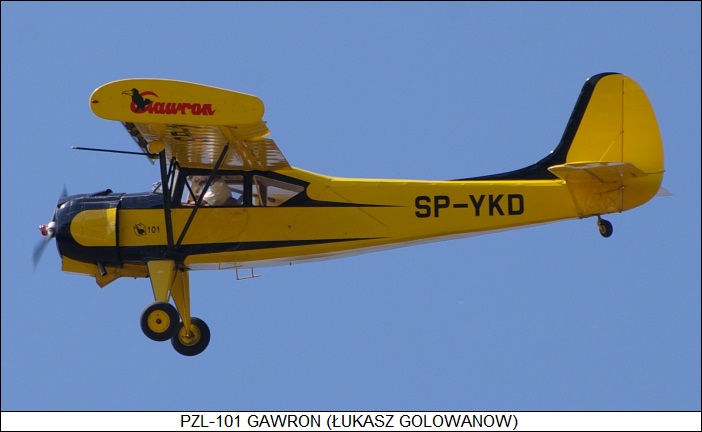
Polish Yak-12s were built in a range of configurations, with 1,150 manufactured up to end of production in 1960. Many were exported to other Soviet bloc countries, including the USSR. WSK-4 went on to produce a derivative, the "PZL-101 Gawron (Raven)", with 325 built, mostly for agricultural use, up to 1972. Yak-12 and derivative machines remain in service, refurbishments being nothing unusual -- a tribute to the utility and sturdiness of the aircraft.
BACK_TO_TOP* The Yak-12 was the only one of Yakovlev's utility aircraft to be built in large numbers -- not counting the Yak-18T, which was a four-seat aircraft based on the Yak-18 tandem-seat trainer, and so discussed elsewhere. However, the Yak organization never gave up on the concept. In the early 1990s work was begun on what would become the "Yak-58", a six-seat business / utility aircraft. A full-scale mockup was completed in 1991, followed by a at least four flight prototypes, the first performing its initial flight on 26 December 1994.
The Yak-58 was of different configuration than earlier Yak utility aircraft, being more or less of twin-boom pusher prop configuration. The "more or less" is specified because in a traditional twin-boom pusher configuration, a boom runs back from each wing to a tailfin, the tailfins being joined by a high-mounted tailfin. The Yak-58 dispensed with the booms as such, instead using elongated swept tailfins that connected to the wing.
The Yak-58 had a long straight wing, with a slight dihedral and turned-down wingtips. It had retractable tricycle landing gear -- all with single wheels, the nose gear retracting forward and each main gear hinged to retract from the wings in towards the fuselage. It was powered, in an interesting link to the Yak-12, by an M-14 nine-cylinder radial, specifically the pusher configuration M-14PT, with 265 kW (355 HP) and driving a three-blade constant-speed propeller. Cooling tends to be an issue with pusher aircraft because the configuration keeps the engine out of the airflow, and so the M-4PT was enclosed by an annular ring cowling that provided all-round ducting, ensuring adequate airflow.
___________________________________________________________________
YAKOVLEV YAK-58:
___________________________________________________________________
wingspan:
12.7 meters (41 feet 8 inches)
wing area:
20 sq_meters (215.3 sq_feet)
length:
8.55 meters (28 feet 1 inch)
empty weight:
1,270 kilograms (2,800 pounds)
MTO weight:
2,100 kilograms (4,630 pounds)
max speed at altitude:
300 KPH (187 MPH / 162 KT)
service ceiling:
4,000 meters (13,120 feet)
range:
1,000 kilometers (620 MI / 540 NMI)
___________________________________________________________________
There was comfortable seating for six -- a pilot plus five passengers -- with three rows of two bucket seats each. There was a car-type door, hinged on the forward edge, on each side of the aircraft for the front row, and a rear sliding door on the right side of the aircraft for access to the rear seats. The passenger seats could be removed for hauling up to 450 kilograms (1,000 pounds) of cargo.
There was talk of Yak-58 variants for air ambulance or military / paramilitary patrol roles, as well as with alternate powerplants, such as flat-six piston or turboprop engines. However, the Yak-58 program went into limbo in the mid-1990s; it sputtered to life again a decade later, but then faded out again. It might end up going into production, but nobody would be sensible to bet on it -- a bit of a pity, since it seemed like a very creditable aircraft.
* While the Yak organization was tinkering with the Yak-58, work was also being conducted on a four-seat utility aircraft of more conventional configuration, the "Yak-112", which was originally conceived in the late 1980s as a two-seat primary trainer for Soviet aero clubs and DOSAAF, the modern descendant of the OSOAVIAKhIM. Specification creep led to the four-seat configuration, which incidentally also led to considerable difficulties in obtaining an appropriately powerful engine -- somehow reminiscent of the engine difficulties that led from the AIR-5 to the AIR-6.

A full-scale mockup was publicly displayed in 1991, with the first prototype flown in October 1992. As it emerged, the Yak-112 was of conventional configuration, with a high-mounted strut-braced straight wing with bracing and downturned wingtips, a swept tailfin and flat tailplane on a slender rear fuselage boom, and fixed tricycle landing gear in spats. It featured extensive glass-fiber composite construction and was powered by an imported Teledyne Continental IO-360-ES flat-six air-cooled engine with 157 kW (210 HP) -- some sources claim the powerplant was the Avco Lycoming AIO-360-A1B6 flat-four air-cooled engine with 150 kW (200 HP) -- driving a two-bladed Hartzell propeller. From its lightweight appearance, it looked very much like a two-seat ultralight aircraft scaled up to a four-seat configuration.
___________________________________________________________________
YAKOVLEV YAK-112:
___________________________________________________________________
wingspan:
10.25 meters (33 feet 8 inches)
wing area:
14 sq_meters (150.7 sq_feet)
length:
6.96 meters (22 feet 10 inch)
empty weight:
775 kilograms (1,710 pounds)
MTO weight:
1,260 kilograms (2,780 pounds)
max cruise speed:
250 KPH (155 MPH / 135 KT)
service ceiling:
4,000 meters (13,120 feet)
range, max payload:
850 kilometers (530 MI / 460 NMI)
___________________________________________________________________
A number of other prototypes were built, how many is unclear, and plans were announced for various configurations and derivatives of the Yak-112, possibly with the Novikov DN-200 air-cooled flat-four diesel engine being used for production aircraft. However, that was as far as it went, the project fading out from the mid-1990s. As with the Yak-58, the Yak-112 or a derivative might go into production eventually, but it might not be a good bet.
BACK_TO_TOP* There were a number of further Yakovlev aircraft in the AIR series, most of which were one-off designs. One of such interesting enough to deserve a note here was the "AIR-7", a tandem-seat air racer / courier aircraft. It was inspired by contemporary American air racers such as early Granville Brothers (Gee Bee) machines, and had a fair resemblance to them -- being a low-wing monoplane with landing gear in streamlined trouser fairings, powered by a Shvetsov M-22 nine-cylinder radial engine driving a two-bladed propeller. The M-22 was a copy of the British Bristol Jupiter radial, providing 360 kW (480 HP).
The AIR-7 had a span of 11 meters (36 feet 1 inch), a length of 7.8 meters (25 feet 7 inches), and an empty weight of 900 kilograms (1,980 pounds). It was of mixed metal-wood construction and featured overwing struts, as well as bracing wires, to permit a lighter wing. It was painted in good Communist red, with silver trim. The AIR-7 performed its initial flight on 19 November 1932, to quickly set a national speed record of 325 KPH (202 MPH). It suffered an accident due to a design defect on 23 November, but the pilot was able to land safely; Yakovlev was under the gun for a time, with his future as an aircraft designer in doubt, but he was able to weather the storm.
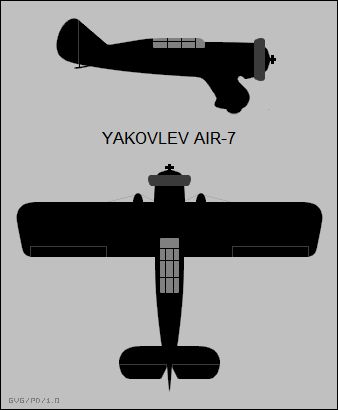
The AIR-7 was repaired, to improve on its speed record in 1933, with a new record of 332 KPH (206 MPH). Only one AIR-7 was built, the aircraft effectively amounting to what the Americans would call after the war an "X plane" for evaluating new flight technology. The machine ultimately suffered the inglorious end of being shot up as a ground target -- nobody having concerns that it might better have been preserved for posterity.
* Sources include:
Some minor details were also picked up off the online Wikipedia.
* Revision history:
v1.0.0 / 01 sep 12 v1.0.1 / 01 aug 14 / Review & polish. v1.0.2 / 01 jul 16 / Review & polish. v1.0.3 / 01 jun 18 / Review & polish. v1.0.4 / 01 mar 20 / Review & polish. v1.0.5 / 01 feb 22 / Review & polish. v1.0.6 / 01 jan 24 / Review & polish.BACK_TO_TOP
